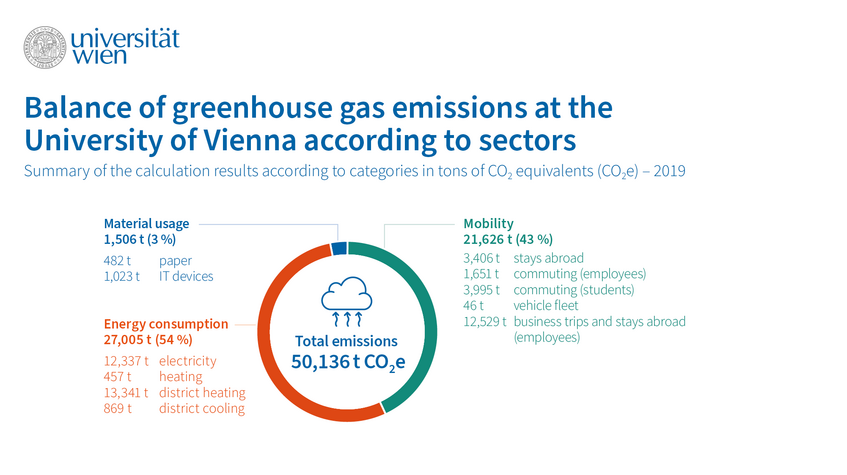Greenhouse gas balance 2019
Along with the objective of achieving climate neutrality by 2030, the University of Vienna also decided to prepare its first greenhouse gas balance. The greenhouse gas balance presents the current status of emissions at a defined point in time and, thus, provides a starting point for the definition of further objectives and measures to achieve climate neutrality.
The University of Vienna has been a member of the Alliance of Sustainable Universities in Austria since autumn of 2021. Therefore, the Alliance’s calculation tool ClimCalc is used for the University's greenhouse gas balance. The consistent use of the same tool at all Austrian universities offers the benefit of better comparability of the data. The greenhouse gas balance takes into account emissions in the areas of energy consumption, mobility and use of resources. The year 2019 has been defined as the basis year of the first greenhouse gas balance and, thus, as the basis for the definition of measures to achieve climate neutrality by 2030 (due to the COVID-19 pandemic, the years 2020 and 2021 were not suitable as a basis of calculation).

Greenhouse gas balance of the University of Vienna: These are the results

Total emissions: 50,136 tonnes of CO2 equivalents. Material use 1,506 t (3%) - this includes 482 t paper + 1,023 t IT devices. Energy consumption 27,000 t (54%) - this includes 12,337 t electricity, 457 t heating, 13,341 t district heating and 869 t district cooling. Mobility: 21,626 t (43%): this includes 3,406 t of stays abroad, 1,651 t of commuting (employees), 3,995 t of commuting (students), 46 t of vehicle fleet, 12,529 t of business trips and stays abroad (employees).
In 2019, the University of Vienna emitted 50,136 tons of CO2 equivalents in total. As the illustration shows, the majority of emissions – 27,005 tons (54 %) – stem from energy consumption. The area of mobility ranked second, with 21,626 tons (43 %). The use of resources accounted for only 3 % of all emissions of the University. However, this might be due to the fact that the calculation tool currently used takes this area into account only to a limited extent.
Based on the greenhouse gas balance for 2019, the University will develop comprehensive, appropriate and far-reaching measures aimed at protecting the climate and the environment and will define objectives in the roadmap for achieving climate neutrality by 2030. This roadmap is currently being developed.
First measures
The University has already implemented the first important measures: It has already been using energy only from renewable sources for several years. Since early 2022, it has also been using green energy certified as UZ 46 including an eco-label for about half of its premises, which is subject to clear provisions and transparent criteria. This green energy is only offered by green power suppliers and must contain a minimum share of power generated by photovoltaics.
Other measures that are already being implemented include the Switch-it off campaign, which launched in spring 2022, and a changeover to LED in lighting fixtures at individual locations, etc. Further measures are being prepared.
Outlook Roadmap to climate neutrality
Based on the greenhouse gas balance for 2019, comprehensive, appropriate and far-reaching climate and environmental protection measures and targets are proposed as part of the Roadmap to Climate Neutrality 2030. Click here for the Roadmap to Climate Neutrality.
